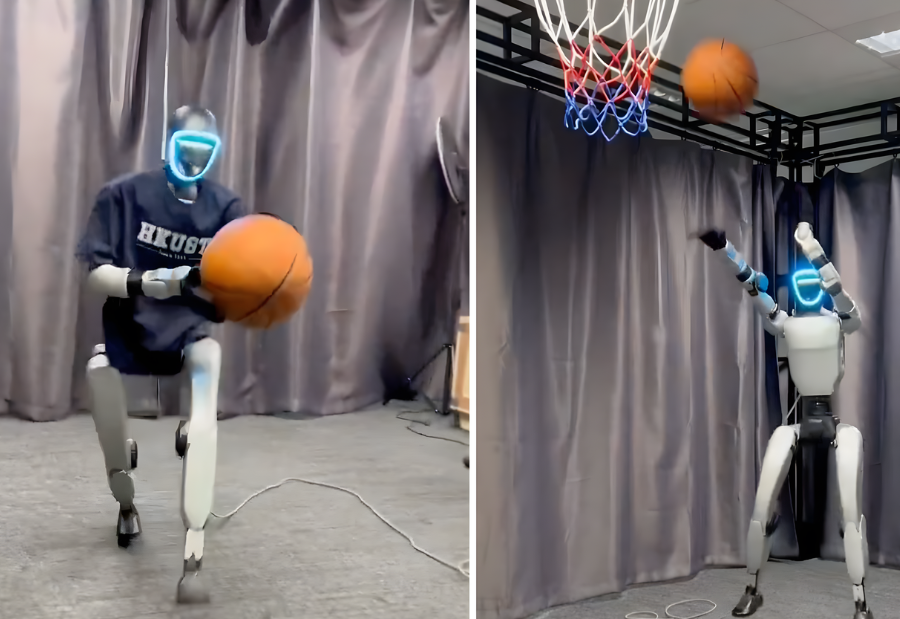A humanoid robot developed with new artificial intelligence tools has demonstrated impressive basketball skills, moving with fluidity as it dribbles, passes and shoots. In a recent demonstration at the Hong Kong University of Science and Technology, the compact Unitree G1 robot, nicknamed Little Potato, performed actions such as dribbling and landing a clean three step layup after thousands of simulated practice sessions.
The robot’s performance is powered by SkillMimic, an AI framework that studies human movements captured through video and motion tracking suits. These movements are then refined through virtual training until they are stable enough to be executed in the real world. This approach allows a single policy to learn different skills and switch smoothly between them even when the reference data does not include these transitions. Researchers said a high level controller can reuse the skills acquired by SkillMimic to handle complex basketball tasks.
A video from the lab shows the Unitree humanoid moving across the court with natural looking control and scoring shots. The team describes it as the world’s first demonstration of a robot performing basketball actions in a real environment. During the session, the robot even attempted a layup that a researcher blocked, but it quickly regained balance and continued playing, showing how stable its movements have become.
SkillMimic V2, the system behind the robot’s progress, addresses a major challenge in reinforcement learning. Human movement data is often imperfect, noisy or incomplete. Instead of relying on perfect recordings, the system extracts useful information even from flawed demonstrations by processing them in advanced ways.
The system works through three main ideas. The first is the Stitched Trajectory Graph, which identifies similar body positions across different skills and links them to create new transition paths the robot never observed directly. The second is the State Transition Field, which trains the robot from slightly different starting points including masked intermediate states, helping it recover from mistakes. The third is Adaptive Trajectory Sampling, which gives more training weight to difficult moments in the motion data so the robot performs reliably during longer sequences.
With these tools, the robot learns smoother and more general skills in simulation, including stable layups and natural transitions between dribbling and shooting. The team trained a single interaction skill policy on seven basic moves using about 4.5 billion simulated samples. Later, only the high level controller was updated while the base skill policy remained unchanged. Tasks like throwing or circling required about 0.4 billion training steps, while scoring needed about 1.2 billion.
Researchers compared their method with three standard training approaches. Systems trained from scratch or using older techniques struggled with ball handling and often failed tasks. Even approaches that used body and object motion did not perform well because their controllers lacked precise interaction skills. SkillMimic performed better by giving the robot strong, reusable skills.
The team said there is more to explore, including training a single policy to handle many objects, learning from smaller datasets and eventually getting real humanoid robots to perform these abilities outside simulation in full basketball games.
Also read: Viksit Workforce for a Viksit Bharat
Do Follow: The Mainstream formerly known as CIO News LinkedIn Account | The Mainstream formerly known as CIO News Facebook | The Mainstream formerly known as CIO News Youtube | The Mainstream formerly known as CIO News Twitter
About us:
The Mainstream is a premier platform delivering the latest updates and informed perspectives across the technology business and cyber landscape. Built on research-driven, thought leadership and original intellectual property, The Mainstream also curates summits & conferences that convene decision makers to explore how technology reshapes industries and leadership. With a growing presence in India and globally across the Middle East, Africa, ASEAN, the USA, the UK and Australia, The Mainstream carries a vision to bring the latest happenings and insights to 8.2 billion people and to place technology at the centre of conversation for leaders navigating the future.




